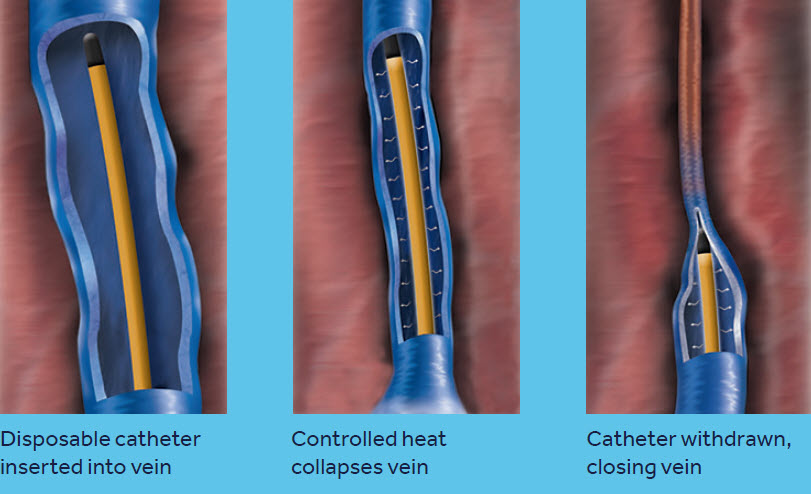Treatment of Vein Diseases
Some common methods for treating varicose veins, spider veins and other venous diseases
The National Institutes of Health (NIH) estimates that 60% of all men and women suffer from some form of vein disorder. A quarter of varicose vein sufferers are men. In both, varicose veins and spider veins, valves designed to keep blood from running backward away from the heart and back down into the leg fail or become loose and flabby — allowing backwash, which stretches veins and even slowly leaks into ankle and leg tissue, causing swelling. Besides the apparent ugliness, these conditions can choke off blood circulation to the skin resulting in painful leg ulcers.
As with any disease, there are various treatment methods. Our doctors will evaluate each patient individually and come up with a personalized treatment plan.
Two of the more common treatments is the ClosureFast procedure and the VenaSeal Closure System.
ClosureFast Procedure
Thermal vein closure
The ClosureFast™ procedure uses radiofrequency energy or heat to close the diseased vein, which redirects blood flow to healthy veins, relieving symptoms.
 The traditional treatment
The traditional treatment
- Minimally invasive outpatient procedure
- Local anesthesia along various points of the leg
- Less pain and bruising than laser treatment
- Faster recovery time than laser treatment
- Compression stockings needed for at least one week after procedure
Over 2 million patients have been treated with the ClosureFast procedure in over 100 countries around the world.
HOW CLOSUREFAST WORKS
The ClosureFast procedure is performed on an outpatient basis.
- Using ultrasound, your physician will position the catheter into the diseased vein through a small opening in the skin.
- The small catheter delivers heat to the vein wall, causing it to shrink and the vein to seal closed.
- Once the diseased vein is closed, blood will reroute itself to other healthy veins.

See the steps involved in the ClosureFast procedure for treatment of venous reflux disease.
Following the procedure, a simple bandage is placed over the insertion site, and additional compression may be provided to aid healing. Your doctor may encourage you to walk, and to refrain from extended standing and strenuous activities for a period of time. The average patient typically resumes normal activities within a few days.
Nonthermal vein closure
The VenaSeal™ system delivers a small amount of a specially formulated medical adhesive to seal — or close — the diseased vein, rerouting blood to nearby healthy veins, which provides symptom relief.
A more comfortable experience
- Simple, outpatient procedure
- No tumescent anesthesia
- Less pain and bruising than thermal ablation
- Faster recovery time than thermal ablation
- Compression stockings not needed after the procedure
More than 100,000 patients have been treated with the VenaSeal closure system around the world.
HOW THE VENASEAL SYSTEM WORKS




